On 4 November Qantas flight QF32, an Airbus A380 outbound from Singapore, ran into serious problems when a turbine on its Rolls-Royce Trent 900 engine suffered an uncontained failure. We caught up with one of the five pilots onboard, who describes how the crew professionally dealt with the incident, the sequence of events, and how the most dangerous period was after they had landed.
Captain David Evans is a Senior Check Captain at Qantas with some 32 years of experience and 17,000hrs of flight time. At the time of the incident he was in one of the observers’ seat, and thus had a ring-side view of the drama as it unfolded. The other flight deck crew were Richard de Crespigny (Pilot in Command, 15,000hrs), Harry Wubben (Route Check Captain, 20,000hrs) Matt Hicks (First Officer, 11,000hrs and Mark Johnson (Second Officer 8,000hrs). With the Cabin Service Manager (Michael Von Reth) this team boasted some 140 years of experience and over 71,000 flight hrs – a significant factor in the successful outcome of the incident.
We put a few questions to Captain Evans on his amazing story. (all incident pics courtesy D Evans).
ASChan: Can you tell me about your background? How long have you been at Qantas?
DE: I joined Qantas in 1984 – nearly 27 years I’ve been flying. I’ve flown the Boeing 767, 747 Classic and 747-400, Airbus A330 and now the Airbus A380 for the past two years.
ASChan: What does the conversion training to A380 consist of?
DE: In my position I was a check pilot on the 747-400 and part of the requirements were to have some Airbus experience for Australian CASA (Civil Aviation and Safety Authority). As the A380 was a new type, and we were a launch customer, they required us to have some Airbus experience. My training involved an Airbus A330 endorsement and fly that aircraft type (as it turned out for two years) mainly because the A380 was a little bit late from Airbus, and then the type conversion from 330 to 380 which was a lot easier than the 747 to A330 conversion.
ASChan: In terms of the QF32 flight itself – which seat were you on in that flight? What was your responsibility?
DE: My job on the flight was supervising check captain. We had a captain who was undergoing training to become a check captain who was doing a route check on the operating captain. So we had a normal crew of three, first officer, second officer and a captain who was undergoing training to become a check captain, under my supervision – so I was the supervising check captain.
ASChan: Can you give us the background to the flight, weather, time of day?
DE: Qantas 32 was the continuation of a flight from UK to Australia via Singapore. It arrived in the morning of Singapore, touching down around 7am. There was a crew change and basically a refuel stop. We took over to operate the service to Sydney, Australia. We departed Singapore about 9.30 in the morning on a clear, sunny tropical Singapore day. The events soon after departure, very soon after departure, required us to return to Singapore.
ASChan: Can you take us through the sequence of events as they happened?
DE: We departed normally, the aeroplane was relatively light and consequently used a relatively low thrust setting for departure. Taking off to the south-west out of Singapore requires a left turn, tracking out towards the Indonesian island of Batam. As we were climbing and accelerating – basically completing our acceleration stage to clean configuration, passing through around about 7,000ft, the No2 engine, without any warning, exploded.
ASChan: What were you and the crew’s first awareness of the problem? How did you notice it from the masses of messages you must have had?
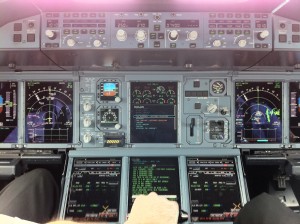
One of a series of Cockpit pics during the emergency by Harry Wubben, Route Check Captain using an iPhone (via D Evans).
DE: The first thing, of course, was the noise that alerted us to something had gone wrong. In my position in the second observers seat, so I didn’t have a good view of the instrumentation at that stage. Standing up and looking over the first officers shoulder, it was quite obvious we had a major problem with our No2 engine. Very soon after departure we had a number of ECAM (electronic centralised aircraft monitor) messages. The first one was ‘Engine 2 turbine overheat’. That requires the thrust lever to be reduced back to idle with a time condition, which is round about 30 seconds and wait for the turbine temperature to settle. During that 30-second period the message reconfigured to an ‘engine fire’ momentarily and then went back to the ‘turbine overheat’ message. The time condition re-set itself to another 30 seconds. The first officer had the presence of mind to start a stopwatch and it was obvious that that 30 second period had passed, so we (as in the operating crew) proceeded to shut the engine down as per the ECAM requirements.
ASChan: When you have this many crew on the flightdeck, what is the division of responsibilities in tackling the problem? Who does what?
DE: The Airbus system is you have a pilot flying and a pilot, non-flying. The Captain was the pilot flying, Richard de Crespigny, and the initial response is ECAM actions. As the pilot flying calls those responses, he assumes responsibility for flying the aircraft and the radio. The First Officer then proceeds to action the checklists. And our role, my role as an observer on the flightdeck at that point was literally supernumerary – we were watching the actions.
ASChan: How controllable was the aircraft after the incident? Do you think if it happened further into the flight, away from a diversion field the rest of the systems may have packed up?
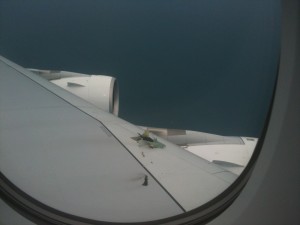
The view out of the wing following the explosion. The nearest hole was the path taken by the turbine disc, which is still missing.
DE: I don’t think so. The engine explosion, if it happened later in the flight, probably wouldn’t have made a lot of difference. We had a number of checklists to deal with and 43 ECAM messages in the first 60 seconds after the explosion and probably another ten after that. So it was nearly a two-hour process to go through those items and action each one (or not action them) depending on what the circumstances were. Our role in the backseat was to deal with some serious issues as we were doing each item. We were part of the CRM (Crew Resource Management) process, to either suggest to go ahead with the procedure or not. Certainly in the case of some of the fuel messages we elected not to open cross-feed valves and try and transfer fuel in a wing that had obvious damage.
ASChan: What happened next? You’re dealing with the messages one by one – take us through recovery and getting back to the airport.
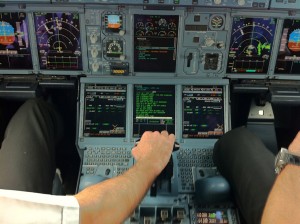
The A380 glass cockpit – note the top centre panel showing only Engine No 3 is operating normally – the Number 2 having suffered the uncontained failure, while 1 and 4 are operating in ‘degraded mode’.
DE: I think the timeframe was nearly two hours which went by in the blink of an eye really. Certainly with the obvious damage to the aircraft the first thing we needed to establish was some calming PAs to the passengers, which actually was my role and I made the first PA. Then also co-ordinate our cabin crew and basically keep the passengers informed as best we could as we went through the process. We made it quite clear it was going to take some time and we would keep them informed as best we could. The process – the first things we dealt with were the engine overheat, as I mentioned, and the shutdown of the engine. In the shutdown process the ECAM has an option of ‘damaged’ or not and of course we chose ‘damaged’ which then leads you through discharging some fire bottles and shutting the engine down with the fire shut-off switch. We did that but unfortunately we got no confirmation of any fire bottles being discharged. Subsequently that was more wiring damage that didn’t give us the indication. As it turns out, we did have one discharged bottle and one that didn’t which was comforting.
The Engine 2 was shut down. Part of the damage caused Engines 1 & 4 to go into a ‘degraded’ mode. The engines were still operating and Engine 3 was the only engine that was operating normally. Basically, dealing with all those things took some time, then the next series of messages were hydraulic problems. We had indications that the green hydraulic system was losing all its fluid. The Airbus A380 carries two and, unlike most conventional aeroplanes, most flying surfaces aren’t powered by hydraulics, they have their own electric-hydraulic actuators. There is a green and yellow system and they spilt their duties between things like brakes, undercarriage retraction/extension. With the green system out we had to deploy the nose gear and body gear using the gravity extension system. With the loss of the green system we dealt with that and curiously we had the hydraulic pumps of Engine 4 indicating failed as well. Engine 3, the trusty engine, was the only engine that was producing hydraulics for the aircraft for the yellow system.
ASChan: When this was happening, what was going through your head in terms of ‘this seems more serious than an engine shutdown’?
DE: It was getting very confusing with the avalanche of messages we were getting. So the only course of action we have is the discipline of following the ECAM and dealing with each one as we came through with them. The engine shutdown was completed, the hydraulic systems were dealt with and then the next systems we were looking at were the loss of various flight controls. This was due to the degradation and the loss of some electrical buses, bus 1 and 2 had failed. Basically, just going through the ECAM actions, acknowledging them and working through the systems display to see what was working and was not.
The next thing we were dealing with was the fuel. We had some obvious leaks, some severe, out of the Engine 2 feedtank. We dispatched the second officer back to the cabin to have a look and there was a fairly significant fuel trail behind the aircraft – or fluid trail because at that stage we couldn’t determine whether it was hydraulic fluid or fuel. We were getting messages about imbalance, losing fuel out of one side and not the other. And those messages were some of the ECAM messages that we didn’t follow. We were very concerned the damage to the galleries, the forward and aft transfer galleries, whether they were intact, whether we should be transferring fuel. We elected not to.
We ended up with quite a significant imbalance between the two – nearly ten tonnes of fuel. That took time to absorb and discuss whether we should or shouldn’t. Subsequent to the hydraulic system we lost some braking, the wing brakes went into what they call the emergency system – ‘accumulator only’- this gives about three or four applications before the accumulator runs out of brake energy. Also the anti-skid on the wing gear. Now with the antiskid being unserviceable on the wing gear its very important to have the aeroplane nose gear down that limits the braking on the wing gear to 1,000psi. If you have lift and not all the weight on the wing gear you run the risk of locking the brakes up and bursting tyres.
Then we come to the electrical system. Bus 1 and 2 we’d lost. We looked to start the APU but it wouldn’t take up any of the load. It just managed to burn fuel - that was all. Engine 1 drive had disconnected. Again there was a procedure to follow. We had pneumatic leaks. We had major air leaks, pneumatic leaks, in the left wing, Engine 2 bleed leak and outer wing leaks. The leak isolation system had taken over to seal up the holes for us – which was a good thing.
We lost one of the landing gear computers and once we’d extended the undercarriage using the alternate system we had no indication it was down until we’d gone to the system page to make confirmation of that. Happily it indicated that the remaining system told us the wing gear had extended correctly. And then the autothrust – with two engines in degraded mode (including Engine 3) we’d lost the autothrust and all the thrust control was done manually. Various vent, air conditioning and cooling systems had also failed. With Engine 1 and 4 being in degraded mode it was discussed whether or not to really use those actively and the decision was made to leave them in a particular power setting and control the aircraft’s speed with Engine 3 only - the one engine that was in a normal mode.
And once we had established all that then we had to work out whether we could actually stop on the runway that was available to us. We didn’t have the ability to dump fuel, the fuel dumping system had failed and we were about 50 tonnes over our maximum landing weight. In the Airbus and the A380 we don’t carry performance and landing charts, we have a performance application. Putting in the ten items affecting landing performance on the initial pass, the computation failed. It gave a message saying it was unable to calculate that many failures. So we then looked at them in more detail and rejected ones that we considered minor and things that were affecting landing performance on wet runways. It was a beautiful day in Singapore thankfully and not wet so it obviously wasn’t going to affect our landing performance. After we’d eliminated about three or four items the computer happily made a calculation and it gave us a touchdown speed of about 165kt and showed us about 130m of surplus runway (it’s a 4,000m runway) so basically said we could stop on the runway. We had also lost the use of our leading-edge slats which consequently with the overweight condition made our approach speed quite fast – 35kt more than normal.
The other thing we were concerned with was because we had lost the ability to transfer fuel we were concerned whether the aircraft’s centre of gravity (CoG) was going outside limits. So we ran some weight and balance applications to determine where our CoG would be and also whether or not we could keep lateral balance. Thankfully it remained within the flight envelope.
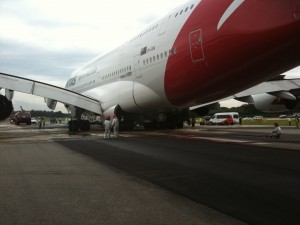
QF32 on the ground at Singapore. With no power to taxi, it took nearly an hour for airstairs to reach the aircraft.
Then we elected to commence the approach. With the loss of various flight controls we decided to do control checks as each flap setting was taken. Richard, who was flying at this stage, elected to take first stage of flap and run through some manoeuvres to make sure the aircraft was controllable at each stage down to configuration 3 (or flap 3). The aeroplane seemed to handle quite well, very sluggish because of the loss of flight controls. Then we elected to extend the undercarriage on the gravity system and then do another series of flight control checks, to make sure it was flyable (which it was) and advise the air traffic control we were ready to make an approach. So we commenced our approach about 20 miles out, at about 4,000ft, giving us a nice, long, stable approach. Thankfully the weather was fine, wind was quite calm and we made the approach successfully.
ASChan: And there was no discussion to go around and try to burn more fuel off to get the weight down?
DE: Under the circumstances we were keen to get the aircraft on the ground. We’d spent nearly two hours in the air at that stage anyway and the longer we stayed in the air, the bigger the fuel imbalance was getting. We knew we could stop on the runway so there was no point in staying airborne any longer than we needed to be.
ASChan: So you landed – the next thing according to reports was one of the engines kept running?
DE: I think the biggest concern for us was when we had stopped on the runway. We’d organised the fire services to meet us at the end of the runway, which they did. We shut down in the normal way. As I mentioned earlier we had the APU running but sadly it wouldn’t take up any electrical load – so the aircraft went into ‘essential power’ or battery power, which gives you the use of only one VHF radio. That was dedicated to the fire commander, the fellow in charge on the ground. He advised us we still had an engine running. So they were very reluctant to come near the aircraft with the engine running. He also advised us we had some high-pressure fuel leaks coming out of the left-hand wing and as we had used maximum braking effort to stop the wing gear temperatures had gone over 900degs C, so raw fuel pouring on hot brakes. So our concerns were obviously fires and we ‘encouraged’ the fire service to come closer, which they did. We made all effort to try and shut down the No1 Engine but unfortunately it continued to run.
From then on, it became an exercise in preserving the passengers as best we could. We had the aircraft with no air conditioning and its about midday now in Singapore – so its getting very hot in the cabin. We’ve lost our satellite phone so the trusty mobile phones came out and called the company in Sydney to relay back to the company in Singapore, to dispatch some stairs and buses to the aircraft. We were 4,000m down the end of the runway and steps don’t go very fast so it was nearly an hour before we got the first set of stairs to the aircraft and another hour by the time the last passenger departed the aircraft. So it was nearly two hours on the ground with major fuel leaks and engines running.
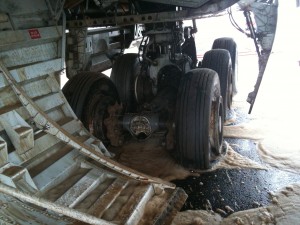
View of the main gear after landing. Note the fire retardant foam. Brake temperatures reached 900deg C.
I think most probably the most serious part of the whole exercise, when you think back at it, was the time on the runway after we’d stopped. Because we were very concerned and conscious of evacuating the aircraft using slides. We had 433 passengers onboard, we had elderly, we had wheelchair passengers, so the moment you start evacuating, you are going to start injuring people. So a lot of discussion was had on the flight deck about where was the safest place for the passengers? We’ve got a situation where there is fuel, hot brakes and an engine that we can’t shut down. And really the safest place was onboard the aircraft until such time as things changed. So we had the cabin crew with an alert phase the whole time through ready to evacuate, open doors, inflate slides at any moment. As time went by, that danger abated and, thankfully, we were lucky enough to get everybody off very calmly and very methodically through one set of stairs.
ASChan: Was that a difficult decision to take to keep everyone onboard the aircraft?
DE: Well of course, you’ve managed to get this thing back on the runway in one piece but you don’t really want to hurt anybody. It’s not a difficult decision, its a process you have to go through to see where is the safest place for passengers. It was a unanimous decision it was onboard the aircraft – until things changed if they had changed. We had the cabin crew primed and ready to go if things deteriorated.
ASChan: Following the incident, what lessons have you learnt from this, what lessons has Qantas learnt from this? Is there anything you think you would have done differently or the crew should have done differently?
DE: Its one of those things that because we had five of us on the flight deck – of course there are lessons to be learned but I think on the day we did absolutely everything. In hindsight I don’t think any of us would have done anything differently. Questions were asked ‘why did we spend so long in the air’? But we had to spend that time in the air to determine the state of the aircraft and it took that long to do that. I think we made the right decision to keep everyone on the aircraft. We had the contingency to evacuate the aeroplane at any moment if things deteriorated. We had fire services in attendance. Certainly we had an engine we couldn’t shut down and that engine continued to run for another five hours before the fire services drowned it with fire retardant.
Lessons learnt - Qantas had a very sound system in place – because we’d spent nearly two hours in the air, the crisis centre in Sydney had been convened. All things were going very well from a company point of view. I think the initial reports coming through, even before we had landed, was the aircraft had crashed. The company was aware of that – because we’d lost our No2 electrical bus we’d lost the satellite phone, so we couldn’t communicate airborne directly with the company. They were getting telemetry from the aircraft that it was still flying.
ASChan: You had five crew on the flight deck. Do you think a standard crew of two would have been able to cope?
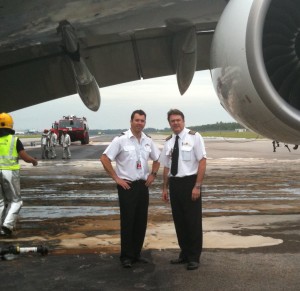
First Officer Matt Hicks and Senior Check Captain David Evans underneath the wing of VH-OQA after landing.
DE: That’s a very interesting question. Really we’ll never know the answer to that. In reality I would hope to believe that a normal crew complement would have dealt with it, cope with it in exactly the same way as we had. We just had the luxury of two other individuals to confirm the decisions that were being made by the operating pilots.
ASChan: So a standard crew would have done the same thing, but perhaps taken a little longer?
DE: May have done, may have done. But I think the end result would have been exactly the same.
ASChan: Going forward are there any recommendations for Qantas to modify its training, or Airbus to modify its training to perhaps generate these kind of ECAM messages in the sim?
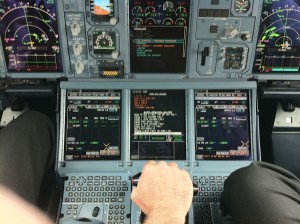
The A380 centre console – note the alerts on the centre MFD. It took the crew two hours to work through these before landing.
DE: Its interesting you ask that question. We tried to recreate it in the sim and we can’t! I think it was just such an extraordinary day. Yes there are always lessons to be learnt, but training has been confirmed that we are training well. I’m sure Airbus will look back at its systems and there will probably be changes because, in our case, we had, as an example, messages that would say ‘aircraft CoG out of limits’ and was asking us to move fuel from horizontal stabiliser forward to bring it within limits and the next message would say the ‘THS transfer not available’. So one message contradicting another – that sort of thing, I’m sure would go back and be looked at. But at the end of the day common sense and airmanship takes over. We didn’t blindly follow the ECAMs. We looked at each one individually, analysed it, and either rejected it or actioned it as we thought we should. From a training point of view it doesn’t matter what aeroplane you are flying airmanship has to take over. In fact, Airbus has some golden rules which we all adhered to on the day – aviate, navigate and communicate – in that order.
ASChan: Interesting you mention airmanship. As a training/check captain are you personally worried about the next generation of pilots who may be fixated with the glass cockpits?
DE: Absolutely. Nothing will replace experience. In a legacy airline like Qantas where we have the luxury, if you like, of very experienced pilots (the most junior pilot to the most senior all have extensive backgrounds in aviation – whether it be military or general aviation). That can’t be replaced.
ASChan: What’s your opinion of the A380’s survivability compared to other types you have flown?
DE: Well I think the Airbus A380 – it’s a testament to the aircraft that we managed to get the aeroplane successfully on to the ground. The fly-by-wire system, albeit with the damage we were in an alternate law, it still was very flyable. Now comparing that to other types I have flown I am sure that Boeing types would have been equally flyable, but they would have been a lot more difficult, I’m sure.
ASChan: Finally how does this incident rate in terms of other emergencies you have faced in your career?
DE: It’s pretty well up there! I’ve had other incidents in the past. My background is not military its general aviation- I’ve had engine failures in light twins – and aircraft that don’t perform very well. But this is probably the most spectacular by far!
ASChan: Thank you very much for your time.
Conclusion
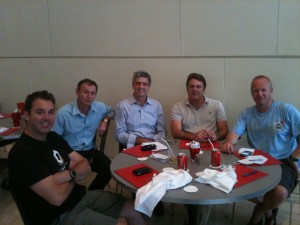
A relived QF32 crew the following morning in Singapore. (From L to R First Officer Matt Hicks, Check Captain Harry Wubben, PIC Captain Richard de Crespigny, Senior Check Captain David Evans, Second Officer Mark Johnson.)
As Captain Evans notes this crew had the ‘luxury’ of five experienced pilots to draw on when the incident occurred. But there are other salient points – the ‘avalanche’ of messages from the A380’s systems (some contradicting each other) meant that the crew drew on their full resources to decide which were important and which could be disregarded. Another key point was in ‘tricking’ the performance calculator to come up with an acceptable landing speed – again a demonstration of superb airmanship so vital in these incidents.
Another facet is the robust construction of the A380 – despite multiple failures in engines, hydraulics and electrics the aircraft degraded gracefully and was still flyable.
Finally Captain Evans draws attention to the training and professionalism of the 24 cabin crew, who kept anxious and increasingly hot passengers calm and under control, not only in the air but also on the ground while they waited for the stairs to arrive.
This incident then, while extremely unusual, goes to show the value of training, experience and the most professional type of CRM (Crew Resource Management) practised by Qantas.
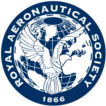


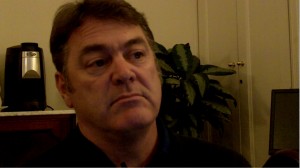
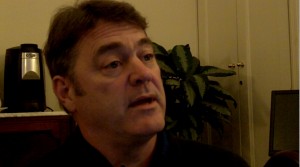
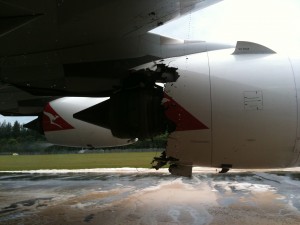
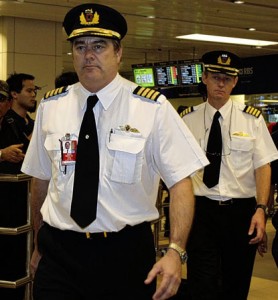

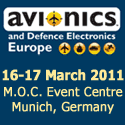


I very much enjoyed getting a report from this incident from one of the cockpit crew at the time. As a former Airbus employee, I know that the FAA / EASA certification teams are extremely demanding concerning proof by the airframe designers that an uncontained engine failure doesn’t cause loss of control of the a/c. It seems that the A380 meets those requirements. However, it also helps a lot when you have well experienced pilots in the cockpit when in disaster strikes.
Truly fascinating reading. What a coup!
A composed, and controlled conclusion to what was a hopefully “one-off” event.
All who handled the event to a successful outcome, be it on the flight deck or the cabin, are to be congratulated for performing to the highest standards of the aviation industry.
Barry Carlson
A very good and comprehensive report
Peter, I used to work at Sydney Hospital , Biochemistry dept between 19972-1977 with a woman, Dagnija Marosseky. Are you related? I was from Perth (still live here). Maiden name, McClelland Perhaps it is a small world.
Happy New Year Ros, yes that’s my wife and she sends her best wishes…
In the rush of self congratulations - 400 passengers in an aircraft on the ground with the engine running - a major fuel leak - for up to two hours - I think not.
A precautionary deployment of chutes on the dead side with passengers lined up ready to go if need be, much more prudent
I’ve never been on a plane when the emergency slides have deployed - surely the noise would have sparked panic and a stampede for the exits?
Deploying a slide before an evacuation has been deemed necessary is also unwise. Should the outside conditions become dangerous you have no way to reverse that and you are leaving an entry point for smoke/fire into the cabin.
The procedure that Captain Evans described is used by Qantas for those exact situations- where it is not quite urgent enough to evacuate immediately, but there is doubt as to the safety of the passengers and aircraft.
Taking the time to evaluate the situation as they did was definitely the right thing to do (said with hindsight & from the comfort of my living room, to be sure)
As he said, the passengers AT THAT TIME were safest on the aircraft. No point throwing elderly and/or disabled people down slides where injuries are a given (read evacuation statistics) unless things deteriorate to a point where life is in danger. At that time, deploy the slides and evacuate them by any and all necessary means. Then and only then are broken limbs, cracked heads etc worth the risk.
As he mentioned, the crew were ready to go. In the procedure that Qantas use, once the Alert Phase has been initiated, the cabin crew will NOT move from those doors until told to either Evacuate or Stand Down (resume normal operations). What we saw here was a Precautionary Disembarkation, which is more urgent than normal disembarking but one step down from a full evacuation.
Background: 5 years cabin crew, 2 of which with Qantas, numerous in-flight emergencies including engine problems & medical cases, and one ‘Alert Phase’ as described above. Now flying with an international airline which does not have this procedure (and feeling less comfortable as a result of it)
Hats off to these guys though, that must be the longest Alert Phase on record and would have been extremely tough on the nerves.
Just wanted to add, I have done a slide descent multiple times from both decks of the A380, and I can tell you it’s
a) bl@@dy scary! and
b) not something you want to do lightly, especially with elderly, children and so forth.
Could not one of the slides have been put down to let out the young (not children), reasonably fit and athletic passengers, with a view to evacuating the others more quickly in the event of a further emergency on the ground?
The thought of leaving all on board in that risky situation, & electing to not evacuate unless (say) the fuel finally ignited seems to me to be totally irresponsible. Th eexcuse of possible perils to the elderly could have been overcome by at least evacuating many of the passengers who did not meet that description, leaving a reduced number of passengers on board at risk if the situation deteriorated to require an evacuation. Indeed, the pilots said that if evacuation would be needed, they only had 90 seconds to evacuate the plane - surely taking some off would have reduced the pressure if the situation took a sudden downturn.
I can’t see their actions on the ground as good management, just as ‘bloody lucky’ to the passengers they were resonsible for.
…Certainly we had an engine we couldn’t shut down and that engine continued to run for another five hours before the fire services drowned it with fire retardant…..
This contingency puzzled me a bit. Would it not have been possible for Airport Fire Service vehicles to come up close enough to direct one or two jets of fire extinguishing foam at high pressure directly into the engine intake? Since the engine was idling, that would surely have flamed it out immediately?
400 passengers and no a scratch on any of them. No secondary damage to the aircraft. The guys got it right. they are a credit to the industry and we should be proud to be part of an industry made of such men
Interesting comments here. The ‘runaway’ engine was according to Captain Evans at idle power, so although a concern, was perhaps not as dangerous as it might at first seem.
Re Geoff Ashton…
Fire retardent foam everywhere…would appear that the fuel leak was well contained, not a 2 hour ticking bomb…its what fire teams are trained to do. As for lining up the pax at an open door for 2 hours, irritable in a stinking hot aircraft, and understandably unsettled after the flight… on the assumption that the fire crew in attendance were not on top of the situation…I have to admit this option didnt come up in my training. Great idea, Geoff.
Richard, I hope you were given a ’5′ for your R/C. Harry should have been satisfied!! A great job!!
Hi Tony,
Thanks for the kind comments. I am very proud (if not conceited) of the achievements of the tech and cabin crew. It was a challenging time and all the teams worked the problem to a happy conclusion.
Kind regards
Rich
I understand the feeling of being overwhelmed by ECAM messages during an emergency like this. The luxury of having two additional senior pilots alongside was the most important factor in this whole incident. Also that the incident happened close to WSSS also played an important part as the bird could be brought back before the performance degraded beyond controllable limits. Bravo!!
@ Tim: There was no controlling, nor firefighting-capability for the engine next to the exploded one (No. 1). Even with it at idle speed: I consider that very serious…
10/12/2010 Have just read this factual account and am awe strucked, fantastic effort from the Captain in Command to the Cabin Staff, a brilliant effort. I salute you all. Regarding Geoff Ashton’s comments “You get one in every group” obviously he can’t see the total picture -wonder what your occupation is/was?
Captain R.O. Pearce retired.
An amazing display of experience,training and good CRM and a well designed and built airplane made this potential air tragedy into a simple incident.
They were also lucky-of course things would be a bit different if,for exzmple,the weather had been bad in Singapore and they had to land under intense rain or strong crosswinds or something like that,perhaps the outcome might not have been as pleasant as it actually was.
Regarding Mr.Ashton’s remark:yes,you have a point but the escape slides would preclude the use of stairs which are safer for passengers to use and also,as capt.Evans says,they had elderly passengers and passengers requiring wheelchairs-obviously not so good to throw them through an escape slide…
Ross
Yes you do get one in every group, but maybe your the one
Its strange what double standards are used in the industry - just fueling an aircraft with passengers on board you cant even use a mobile phone. Yet just to amplify my last - fuel leak, running engine, hot brakes, but most importantly a totally unknown damage situation and high and low pressure fuel and oil pumps still active and your still feeding first class passengers gin and tonic for two hours and waiting for stairs to come up.
I will fly with you anytime and anywhere. Your professionalism and proven skill makes you superior “airman”
To Geoff Ashton,
It is very easy to sit at your computer and pontificate.
You still didn’t specify what your occupation is/was.
Great job guys, I’m proud to have once been part of the team.
Len Krawczyk Capt.(Ret.)
Geoff I highly doubt that during this period of time (ALert Phase as I described in a previous comment) that the crew would have been “feeding gin an tonic” to first class!!!
Again, what (if any) is your aviation experience (aside from MS Flight Sim or the odd trip to OOL on Virgin??)
Geoff Ashton, you seem to avoid to answer the earlier indirect question about your piloting background and on what basis you feel your “opinion” trumps the unanimous decisions of 5 pilots with 71,000 hours of flight hours that resulted in the best possible outcome of the situation. Yes?
People. Having no clue - but an opinion.
[...] mit einem der QF32 Piloten: EXCLUSIVE - Qantas QF32 flight from the cockpit | Aerospace Insight | The Royal Aeronautical Society Boy oh Boy , war das Ernst! Flying with me?Check out my flight calendar here - Courtesy of [...]
Hours and hours of boredom intersperced with moments of stark terror
Major kudos to these brethren airmen. I agree that five experienced pilots aboard made a huge difference, for many reasons, including the time required.
NWA had a similar, if less noted or serious incident on a 747-400 many years ago, NRT-JFK, with a #1 pylon fire seriously degrading the wiring bundle. Any of the four experienced pilots aboard would tell you that having a) experience (airmanship) to evaluate the applicability of eachfault message, or even their factual basis, and b) the sheer workload involved, demanded more than a basic crew complement.
Yes, we know who is the ONE. I was not there and would hardly purport to judge a choice as right or wrong.
The results speak for themselves and very highly of a well established CRM culture. As I remarked to my buddy-on-Hudson before the official FAA Q&A, “if they say you violated book procedures, tell them the book is wrong”.
@ Lord
I am not trying to force my opinion on anyone, but simply saying that DEPLOYMENT of chutes, deployment of passengers within the aircraft ready to use them if need be would perhaps have been prudent in the circumstances.
In this 24 hour news cycle - bad for company image of course with deployed chutes, but then again if the whole thing goes for a ball of chalk - its just the captains fault. My experience - 50 years as a pilot - lost track of aircraft types from Boeing down -years of intercontinental ops as captain and my share of engine failures.
Yes results do speak for themselves, but usually only if they are successful ones and aviation history is littered with fatalities where crews on the ground after an incident cant get their mindsets into emergency mode and have ready all facilities at their disposal and the will to use them
My last word
Geoff,
I have studied the decisions made to Evacuate/Disembark from aircraft for about 35 years. I have factors that help my decision much as you have yours. I reviewed pilots’ decisions and imagined what I would do in the same circumstances. You know how many factors go to helping you decide what to do, so there is not space to discuss them here.
We did the best thing we could do for the passengers at that place, at that time in those circumstances. You might have done something different - and may have also been successful and right.
This is ultimately the captain’s decision (made in consultation with others) and this is what we have to do.
The passengers’ well being is always the #1 priority.
None of this should be new to you….
Cheers
Rich
At the
Hallo Geoff, your good judgement helped you to avoid fatalaties in your fifty year long carreer (“…fare share of engine failures”). Great. You have learned to review all the options before you take a decision. The unparalleled nerve-racking events of QF32 would have prompted you to do the same. DE explained the reasons for their unusual step not to evacuate the passengers. In my opinion (17000hrs on B737 and A310) they did just the right thing! In their minds they were well aware of your mentioned risks. But they also thought about the huge amount of passengers hurting themselves, sliding down from dizzying heights (have you ever seen an A380?) onto a fluid polluted surface. The crew kept calm, which was their biggest asset, weighing up the risks and took it all on their own shoulders! Well done: no injuries!!! Please tell me about any evacuation from a widebody aircraft without injuries in the past. I am curious. The QF32 crew did care about their passengers and did not transfer their responsibility to the medical care industry/profession. I forgot: it was your last word! No more communication? Why? Good airmanship requires conclusions and revisions after decisions.
I think this was handled very well, given the conditions being dealt with.
My only question concerns the engine that would not shut down: “Certainly we had an engine we couldn’t shut down and that engine continued to run for another five hours before the fire services drowned it with fire retardant.”
Why wait so long?
It would seem to me that the uncontrollable engine, fuel leaks, and other unknown damages would have negated (from a safety standpoint) the possible benefits of continuing to troubleshoot that engine.
I have a few theories as to why you would choose this course of action but they don’t seem to me to be the wisest course of action compared to just letting the fire crews drown it out as they ended up having to do five hours later anyway.
Was a reason for the delay specified?
thanks, and again…overall very well done!
As an Australian I am very proud of the experienced flight crew and of course Qantas. When things go wrong it is reassuring to know the experience and training kicks in. Superb job guys. Thank you!
Bastante educativo.
Muito bom trabalho!
Obrigado pelo relato.
How about introducing a procedure to pre-position relevant ground equipment (steps, buses, tug and towbar) near the anticipated stopping point? Obviously only implemented at captain’s request following declaration of a landing emergency with expected inability to taxi. This brilliantly handled incident demonstrates the need for such a plan to be incorporated into every airport authority’s procedure book.
As for Mr Ashton’s remarks, pre-deploying slides exposes them to puncture and other risks. And what happens when the steps do arrive - jettison them as liferafts? This crew got it right!
Hell of a good job.
“if they say you violated book procedures, tell them the book is wrong”.
Oh YES. Thank you for that. Profound.
well done. Dustin Hoffman would be so pleased.
Well done guys, great result. Having been in one & seen countless other accidents, it’s so easy to be clever after the event. But to get it right when the fuse is burning - it’s not a video game!
[...] when the engine popped. See the below link. 2 hours of checklists after 42 warnings. http://www.aerosocietychannel.com/aerospace-insight/2010/12/exclusive-qantas-qf32-flight-from-the-co... Adv Reply Reply With Quote Top + Reply to Thread [...]
“How about introducing a procedure to pre-position relevant ground equipment (steps, buses, tug and towbar) near the anticipated stopping point?”
Already a standard action at many airports, but obviously not at WSSS
My issue [as one B747 captain] would have been with the cabin heat index generated by 400+ pax midday in a hot tropical climate with no conditioned air flow for up to 2 hours…. a possible environmental emergency that could have morphed into an acute health hazard, especially for elderly pax. Were the doors opened?
I expect the extra hands on board made the situation much more comfortable for the operating crew, and therefore probably influenced the operation very positively. It’s ridiculous that an airplane the size of a 380 and carrying that many souls cannot afford to routinely crew an extra pilot, a cruiser even.
As a mere 4000 hr CFII I seriously wonder whether my airmanship would have been up to it? Congratulations in a job well done by all concerned.
Nevertheless, the message flood appears to be a problem in itself (2 hrs of checklists? Good grief!). Analysis of the message sequence needs to be done to see which could be eliminated (since contradictory/superfluous).
Certainly we can not question the reality that all paxs crew and aircraft are safely on the groud (flite QF32). And for that we must recognise the expertise of all involved and the construction and design of a magnifesent airplane. However, most aviation people realize that with complex flying machines disaster lies with a botched procedure or an unseeing eye. To me this incident suggests a need for a very critical examination of the engines, procedures, electonics and their software and of course, the airframe and its control systems. excellent report. Thank you. David Fernandez
Let’s put that Qantas team up for Aussies of the Year
Geoff,
Open doors, with chutes already inflated, and only a flight attendant between the inside and outside of the aircraft is giving over control of what happens next to the lowest common denominator within a 400 passenger aircraft.
While easy to see why one might believe it is a reasonable course of action, having the flight crew give over their complete control over ANY part of a potential DIRE emergency situation is somewhat less than optimal, especially when the ONLY communications link between the aircraft and the ground was the Commander’s VHF1 channel. Sure, cell phones were probably being used, but only the Commander was coordinating actions with the Fire Chief.
As was stated, jumping onto a chute from the height of the A380 passenger door is ASKING for injuries. I’m not sure if you have seen the aircraft close up, but it is a LOOOONG way down.
We will never know what might have happened if the fuel leak had ignited, but DO know, with certainty, that the conservative decisions of the Commander, after consulting with his entire crew, led to NO injuries and a safe outcome.
Again, I do not dismiss your concerns about what could have occurred, nor do I think it is a poor personal decision to line people up at inflated slides at open doors on an aircraft that has just landed after an emergency. The only thing I DO question is the fact that the traveling public has been conditioned that when the doors open and the slides inflate, it is time to jump to save your life. THAT creates panic and often injures people BEFORE they even jump. For that reason, I believe a correct decision was made in this SPECIFIC instance.
Congratulations on such longevity! As the saying goes, you must not be a bold pilot….and I mean that as a compliment.
Well done — goes with the “water landing” of the A-320 in NYC.
Cy
As only ever a humble passenger who trusts the pilots and crew with my life and therefore probably out of place on an industry website such as this, this is a scary, yet gripping and somewhat reassuring account.
You never know when the time is up, but if something does happen, you want to know the people up front are the best trained and pragmatic they possibly can be under such pressure. There is a reason “Qantas never crashes” - it isn’t just a line from a movie!
As for Geoff Ashton, I don’t care about your 50 years experience in all sorts of aircraft - you might be the best guy there ever was at the controls, but put simply, you were not there, so you are in no position to criticise the decision they made in the heat of that moment.
If I was a passenger, and they got me down and off safely without a scratch, even with a long (and no doubt frustrating and scary) wait, I would hug them all every day for the rest of my life if I could - they got me on the ground, I would trust they knew what they were doing if they were keeping me there for a while. Take that from someone whose life you are charged with as a pilot.
They got it right, don’t be critical when you weren’t there. But Portland Bill’s suggestion of having stairs, etc nearby or enroute does sound like a sensible suggestion for a learning from this incident.
There is the passenger’s point of view!
Can someone explain this please - “Part of the damage caused Engines 1 & 4 to go into a ‘degraded’ mode.”
I understand how Engine 1 may be affected by the explosion on engine 2 - damaging the control wiring/hydraulics in the port wing but I don’t understand how engine 4 was also affected.
Any A380 experts out there who can answer this in more detail?
An excellent combined effort by the Flight and Cabin Crew and one without equal.
I had occasion to witness in Brunei a Singapore Airlines B747-200 with JT9-7Q engines fitted which was unable to shut down #1 engine after landing.
The aircraft was on a proving flight,having just been delivered to the airline and had probably only twenty or so flying hours total. there were very few passengers on board who had been carefully selected for this flight.
The engine in question was eventually shut down, presumably using fuel isolation procedures, but cannot expand on the situation.
The cause of the problem was ,to my knowledge,a foreign object in fuel system but there again no specifics.
As a retired Aeronautical Engineer with 40 years in Civil Commercial Aviation, I am more concerned with the aircraft systems and the remedy to preclude an uncontained engine where failure of redundant systems do not effect the aircraft operations.
I suspect Airbus and Rolls Royce will take a hard look at the myriad of problems manifested by this incident and that the Certifying Authorities will keep a watchful eye on the measures taken to eradicate a future occurrence.
Well done QANTAS!!
Outstanding crew performance, excellent judgment, CRM implementation, and decision making. Congratulations to all crew members.
Jan Trojanowski (retired Continental Airlines captain)
Many thanks to this professional crew for sharing the details and lessons learned from their experience. Once again, the synergy between, knowledge, experience, training, leardership and CRM allowed a crew to create a positive outcome. An effective balance of technology AND airmanship cannot be overemphasized.
Well Done!!
James Blaszczak B777 CA
Simply courageous.
Some very fine and considered decisions used had won the day, with prudent emergency actions on standby. I believe they were right to follow their action path and demonstrated that pilots don’t only need flying experiance but need to understand how to micromanaging serious situations. Probably the experience of these guys is the hero but one would like to think that if absent, perception and innovativeness would still be in the arsenal of the current pilot.
I have tons of passenger experience - no flying experience.
I am a retired aircraft accident flight track reconstructionist, developer of the US FAA’s “NTAP” program, consultant and expert witness.
Just want to say how glad I am not to have this flight track to analyze. The old cliche’ about walking away from a landing certainly applies here.
Great - heroic, even - crew performance!
Having flown the Airbus A-310 i would like to suggest Airbus industrie to kindly make their airplanes simpler to fly.Reading the above article i was specially taking note of the comment the Captain made re.the very very long ECAM procedures.Things like hudraulic failures are too bloody long n complex,followed by the dreaded “paper c/l another badly written and confusing piece of litreature!
One would like to ask if theres the ecam then why should the need be felt to follow up with the “paper c/l”?Also in the paper c/l one has to go forward and backwards between chapters thus greatly increasing chances of a mix up and it has happened many a time.Ridiculous!!!
Thank God for airplanes made by the americans with common sense logic and ease of use!!e.g. The Boeing 777.
Hi, you cannot compare an A310 with the later A - series!
I continue to be utterly amazed at the very fact that these pilots took so long to figure out the way forward, and to complete the multiple tasks required of them.
No less important is my absolute wonderment that airbus didn’t configure the aircraft to include a Flight Engineer, someone that is technically competent with all the aircraft systems, and is there for every flight.
I say, without a doubt, switch out the second officer for a professional Flight Engineer, a giant step forward in my opinion.
Then they don’t need 5 pilots to handle complex inflight problems. (with 500-odd passengers aboard)
It’s just common sense!
Being an aviation enthusiast and student pilot, this was an engrossing read. Hats off to the cockpit and cabin crew for the exceptional handling of an extremely tricky situation. The main thing I can take away from all this is the importance of keeping one’s wits around one, and the vital importance of airmanship (which my instructor keeps going on about; for good measure, I now understand)
So what was the cause of the explosion?
It was an uncontained turbine failure in the Trent 900 engine that caused the explosion. Plenty of detail now with the Australian ATSB reporting the failure was down to a ‘manufacturing problem’.
Latest here:
http://www.flightglobal.com/articles/2010/12/03/350485/problems-in-manufacturing-process-led-to-trent-900-failure.html
To a far lesser degree, I have worked in situations where I have had to make decisions based on experience which over-road the factual information at hand. Having an experienced team to evaluate then validate the decisions I ultimately made was crucial to success.
I am put in mind of Robert Kennedy’s decision which likely prevented the Cuban Missile Crises from escalating to war in 1962. With all the facts in front of him, he advised; ‘ignore the 2nd telex’. The telex was ignored. The 1st telex responded to - catastrophe averted. Your confidence in your experience and training won the day. Very impressive.
David Evans’ answer in regard to experience counting should remind the aviation community of the parlous state of general aviation (GA) in Australia, and the consequent loss of experienced GA pilots. What should have been an vibrant and efficient industry has been seriously damaged by government neglect and a self serving bureaucratic machine. Training in mainstream GA has been reduced to a handful of schools due to the excessive costs and paperwork demands of the dysfunctional regulator, the Civil Aviation Safety Authority. Even Canberra, the nations capital, has lost its last flying school. It behooves all of us in Australian aviation, and especially senior airline personnel, to influence government to reverse this undesirable state of affairs.
My background 45 pilot years, GA airport and aircraft owner, operator, CFI, IR Multi, CP, RPT ops, flying school, charter. Now private ops. Baron and Wren 460.
Great article for me to read, however, “Aviate, Navigate, Communicate” is not an Airbus Golden Rule, but an Airman’s Golden Rule. He also seemed to say a Boeing wouldn’t have responded as well, without really saying why.
Great job on getting the Great White Whale on the ground safely, though. Hat’s off to thim.
Good job and thank you for the interview. I think, all of us should take a lesson from this incident. Happy landings.
Great job gentlemen, you make us all proud.
I also agree with your observation regarding the “glass cockpit fixation” and the continued need for experience.
Congratulations to all.
Paul Granger
767 Check Airman USAirways (retired)
An example of superb crew co-operation and decision making in an extremely complicated and difficult emergency situation. From a retired career RNZAF transport navigator.
Surely the crew members should be awarded “gongs”?
Jack Harrison (Captain, retd)
all said and done it is confirmed its airmanship(Human interface) which saves lives not flyby wire or computer techonology or software techonology it apply to normal day to day life als
Fasninating.The last near prang of such magnitude was the krakatoa volcono ash case.Extremely well handled.points to note:
1.Even car gps”s at times on ground give conflicting advise.2.airbus prang in blore yrs ago was due to not recognizing computer override in time.3.If airbus cannot overcome “2 hr analysis ” design,flt eng suggestion may be viable.4.Ground evac mebbe could have been done in a phased “fit pax”manner.5.Asimov for a peep into the future.
regards kojak(wg cdr kj’kojak bhatt,fighter and heli plus bell 412 offshore 10700 hrs)[email protected],youtube.com/kopterkojak,cdbaby.com/cd/kopterkojak.
As a Singapore resident and having met and spoken with Singapore Air Traffic Controllers on several occasions, I feel that it was not WSSS’s “flaw” in not having stairs and buses on standby.
In this situation, I believe that the decision was made NOT to dispatch these auxiliary “units” that may possibly hinder the fire crews (IMO). This was not a simple engine failure, which are usually designed to be self-contained. This was an uncontained engine failure with a possiblity of a fire or explosion after landing. Buses, stairs, and other ground handling staff would also get in the way of the firefighters if there was an explosion or a fire. I feel that dispatching the stairs and buses after determining it was safe seems like a logical choice.
Of course, this is only my opinion. I probably would never have been able to bring the plane safely back to the runway with my kind of ratings/experience. Kudos to the crew (:
Jon, Singapore
PPL IR (FAA USA), PPL (CAAS Singapore & CASA Australia)
in 1995 similar incident happened to Pakistan Air Force aircraft after taking off from Darwin Australia.. luckily the blades shooted out wards thus saving the fuselage.
http://astroaviator.com/2010/11/17/a380-experiences-engine-explosion/
I should correct my previous comment, “a good report” so it was but the events and the actions of the crew in response were exceptional and should not be in any way down played…
As an A380 pilot in SIA, I must say that if this were to hit my airline randomly, the outcome will NOT be anywhere close and most likely catastrophic since most will not be able to handle jack sxxx, let alone the level of complications that Richard and his team has to face. For this I thank god that it somehow hit the right group of pilots. And well done to the crew in saving the day.
Are the ECAM messages not prioritised or weighted in order of importance/seriousness?
BZ to all concerned.
NTS
An excellent account that makes fascinating reading. I suppose I’m an old fashioned engineer with a distrust of too many electronic gismos. One engine fails, two others malfunction in consequence? I can understand damage being caused to adjacent No 1 when debris flies off No 2, but what happened to No4?
Duplication of systems and separation of channels should surely have addressed this, so there sounds to be something very odd. Then the inability to shut down an engine, clearly complete loss of control over a simple fuel shut-off valve should be impossible.
I hhave worked on aircaft fuel (and other) systems - including very briefly A380 - for many years, I’ve also flown UK to Singapore in a 380 but that’s another story. There may well be an engine lubrication issue but it looks to me as if the electronic systems have taken over and been found wanting. Toomany messages, too little capability.
Many have critised Geoff Ashton. I agree with him having been involved in an engine shut down with an uncontrolled fire indication and then an emergency evacuation down the shutes after landing. Whilst I commend the Qantas crew for the result, I find it hard to understand that after the incident they would still maintain doing the same thing. Two hours is a long time to sort out the integrity of a damaged aircraft, when there could have been a far worse outcome in view of the damage to the front wing spar. I cannot understand why you would leave all those people onboard for that length of time with the risk of the aircraft catching fire. I suspect the height of the aircraft for evacuation was a consideration, but this is the second time in recent years that a Qantas aircraft has delayed passenger evacuation when the result could have been far different, the other being the B747 over run in Bangkok. That accident showed up Qantas operational differences to what Boeing recommended. I’m sure there needs to be a review of many procedures after this but the crew still did a wonderful job.
Just a few thoughts about what went on, on the ground. David Evans did not say that they all sat around waiting for the No. 1 to answer the controls or run out of fuel. The fire crews are often very wary when the chips are down, and that would be more of a factor in a place like WSSS, not for any lack of nerve, but rather because the ‘system’ depends heavily on people doing exactly what they have been trained to do, and operating by the rule book: initiative is not highly prized.
Keeping the pax on board is the best way to keep them safe.
Keeping them seated is the best way to keep them under control.
When I was involved in a max energy abort in Bombay many years ago, the scenario on the ground played out much the way this one did, and decisions we took were similarly carefully considered, and similarly effective.
The fire crew turned up fairly quickly, but would not approach close
to those hot brakes. The requested air stairs arrived after more than half an hour, largely due to an industrial dispute. ATC refused to allow us to taxi until the tyres had all blown their thermal safety fuses. We kept the pax on board, just as QF 32 did, although the cabin crew were cocked and ready to go. We did not want to have people being injured if we did not absolutely have to. The outcome was no pax injuries, and everybody had a nice day. The airline in question ? Yup. QANTAS. Captain David Long played a blinder, and QF 32, in far more peril than we were, played five blinders. Tradition is a wonderful thing.
DonBrown, 20,000 hrs, 747 captain, and CRM presenter since 1989.
Sincere congratulations to the crew for managing a very difficult and incredibly complicated situation so well. You all deserve medals.
As a much-travelled chartered electrical engineer, well-versed in safety systems, it occurs to me that a back-up VHF radio could be useful in future in case the one and only method of external communication had failed. While flying from London to Buenos Aires years ago, the aircraft was stranded at Lisbon because one of three identical radios (duty, standby and additional standby) failed. Why was there no back up on this occasion?
I want to highlight a small detail from the report:
After each configuration change the crew decided to test the flight controls and the a/c reaction to pilot input. This is not a part of any ECAM or Airbus paper procedure. And it shows the common sense resulting from 1000s of hours of flying experience of this crew.
Imagine the same happening to the Kingfisher A320 crew where the Captain was 23 and the F/O only 21 (I will not quote the Indian press article)…
And to mention only the Buffalo crash where the inadequate training of both pilots resulted in a completely avoidable accident!
Shame on airlines for taking shortcuts and coming down to minimum standards to save money. The Governments and regulators should take notice of the practices currently adopted by Ryanair and other LCCs…
My compliments to the crew for an outstanding job done in trying conditions. My wife asked me a question (I’m the pilot, not her) that I now wonder about, WHY DIDN’T YOU MOVE SOME OF THE PASSENGERS AHEAD TO HELP WITH THE C OF G PROBLEM?
The fact of the matter is it would not have been such a big deal on any Boeing aircraft.Two hours to do ECAM and checklists.BULL#@$%!In all that time a Boeing pilot would be home havin coffee or whatever else he prefers!!!!
The Airbus bloke would be in the air still and chances of facing another emergency looming real bright!Do the words “LAND ASAP” mean anything people?????!!!!!
On the contrary Tahir.
Rushing a decision to land, with such a complex ship, could mean disaster. A blown engine on an A-380 is not critical in itself.
However, I do agree that ECAM with a poor priority system is a problem in itself.
In this case, it seems like a crew of 5 is a minimum, just to handle an engine explosion. Airbus has some serious investigation ahead of them.
Still, I cannot help but wonder, if the risk, after landing, was handled optimally. With all due respect!! Even though the 2 hour ordeal in the air must have been difficult, and handled wonderfully I might add, I consider the risk after landing as the highest during this incident. Uncontained engine fire, followed by an overweight landing with maximum braking, hot brakes, high pressure fluid leaks and a running engine, for 2 hours.
Evacuating through slides from a A-380 is a high risk operation, no doubt about it. However, leaving hundreds of passengers on board, with a high risk of an explosive and possibly uncontrollable fire is an even higher risk operation, if you consider the possible outcome. An evacuation would most certainly resulted in some broken hips and sprained ankles, but people don´t die during evacuation…
Nevertheless, hats off. Thank God they were 5 and had experience!! And thanks for an interesting interview
Yeah, this is what it should be called A grade AIRCREW.
Boeing or AirBus means nothing when a turbine disk crossed the fuel tank in the wing!!!
Oh, Good Gratiouse God, You Were Airman that day!!!
Fire was the least that could happen to that crippled airship but think to the crew, what a perfect addition of experience, calm, and knowledge altogether.
Smooth flights and happy landings.
What else is there to say?
They dealt with the problem(s), they landed the airplane safely and no passengers were injured (correct me if I’m wrong).
Outcome for this flight = Success.
Congratulations to all involved in QF32.
Thank you for this report. It has made my day.
No one doubting the crew capability.Just wonderin bout aircraft procedures.Boeing v Airbus.Engine blew up??Get General Electric,the best ever!
Qantas should be allowed to release this interview or even parts of it to the media, as it shows the professionalism of their crew. It stands as a great example to other airlines and gives confidence to passengers who may be wondering what is next. After all Qantas has had a great deal of bad luck of late, but without any casualties. They now deserve to share some of stories behind the front page news.
This interview clearly shows why Qantas has proved to be safer than almost all other Airlines, for so long
Well done crew of QF 32 and well done Qantas, for hiring the best and training them so well..
This report is the most interesting of any incident I have read.My 23 years in aviation have not seen anything so fascinating and tense to read.My congratulations to the crew who acted with such professionalism.
Spoken as an A320 and A340 check airman: Hats off to all of the Quantas crew and their combined experience. Hats off to Quantas flight training, Airbus training and Quantas CRM training. A very dangerous and challenging emergency was handled very sensibly and professionally. Excellent, level headed risk analysis was practiced under very difficult circumstances resulting in a no casualties outcome. No one could ask for more.
A couple of things…Tahir, you should stick to MS Flight Sim. Plenty of GE engines have had uncontained failures. No engine is immune. As for the procedures…it would take ages to work through an equivalent list of failures in a 747-400 (which is, after all, the closest currently available alternative). The EICAS would not prioritize them anywhere near as well as the ECAM, and you’d spend ages flipping through pages on the checklist. I very much doubt that a Boeing would have handled this level of insult any better than the Airbus.
Geoff Ashton, your concept of having the slides deployed, and the passengers waiting in the aisle is a recipe for disaster. You will basically have lost control of the passengers. Also the deployed slides will affect the ability of the fire crew to move vehicles as they need. Keeping people in their seats, but with the crew ready to go in an instant was the right decision..but it took a lot of discipline to make it.
The guys did an incredible job, better, I suspect, than most of us could have managed.
The simple lesson to be learned by airlines and airport authorities is that when the fire service is deployed, a ground service team should also be deployed with the number of stairs appropriate to the size of the aircraft for quick evacuation and lifts to remove disabled passengers and empty the baggage holds. The trauma of the passengers would be very much relieved by a quick, safe evacuation and having their possessions returned immediately for onward flight.
Great job guies!!
ECAM ACTIONS COMPLETED!!
Brilliant airmanship, fascinating article. But what precisely was the timeline around the time of the engine failure? Did ECAM give adequate warning to shut down the engine and thus prevent the turbine disk from breaking up? If not, why not?
It’s easy to sit comfortably at home trying to evaluate the entire scenario from the comfort of an armchair - especially from those who have never been more than a passenger on a wide bodied jet. The life saving decisions and actions taken by the Quantas crew were nothing short of miraculous - keeping cool heads whilst sitting within a potential timebomb descending rapidly through the atmosphere with no place to go except the distant runway ahead was simply heroic.
I am a retired aerospace design engineer (ex-BAe, Boeing, Lockheed) and I well know that a team can design for any eventuality that can be thought of, but it’s always the one set of circumstances no one considered that catches you out. How the turbine components cleaved their way through the Kevlar engine protection shrouds is the enigma that has to be solved in this extreme case.
I have attended lectures by accident investigation teams and whereas most causes of accidents can eventually be solved and actions taken to prevent future failures, it’s the gathering of evidence and application of present and past knowledge that counts, along with the dedicated training and personal experiences of the personnel that have to fly these 400 tonne complex machines.
Gentlemen, I take off my hat to you - Very Well Done.
There is a discrepancy between the statements of Cpt Evans and the findings of the ATSB. Cpt Evans said that the #1 engine kept running for 5 hours after ldg. The ATSB said in its interim report that the engine was stopped 127 minutes after landing.
Whilst I cannot claim any technical knowledge whatsoever of the issues commented on already, I can provide an experiential account of my understanding of being a passenger on this plane when it was forced to make an emergency landing in Singapore – and in particular I would like to comment on Geoff Ashton’s criticism of the decision that was made not to deploy the escape shutes.
I was seated in seat 80B alongside my husband in seat 80A close to the rear exit. We were the passengers seated closest to the rear of the engine when it exploded. We heard two loud bangs and saw a fireball fly past our window; we subsequently saw smoke and a considerable amount of fuel billowing from the affected engine.
The management of this crisis by the Captain and crew of the plane was, in my opinion, exemplary. If there are lessons to be learned from what happened on that day, I believe there could be great benefits to be derived from emulating the trajectory of management of the incident by this lead pilot and his crew. We were kept constantly informed of events as they impacted upon us whilst – wisely – we were not given a full account of the many problems and difficulties that the pilots and crew were simultaneously grappling with at the time. As a passenger I was aware that there was a problem with an engine and that we were returning to Singapore. I felt reassured that this was an issue that was manageable and under control. This was all I was aware of – and all I wanted to be aware of – at that time.
When we approached the runway I was aware of the relative instability of the aircraft as it approached its landing. When the plane stopped we had a clear view of a wide jet of fuel projecting out of the rear of the damaged engine. We were among relatively few passengers who could see this, and in a very short space of time a large lake of fuel had gathered beneath the plane. We were informed that the other engine on the same wing was still running, although all other electrical mechanisms on the plane had been switched off, and we had been guarded against any use of electronic equipment. At this point both my husband and myself were fully alert to the danger we were in; we were acutely aware that the plane could easily have gone up in flames at any second. We felt some relief when the firefighters had covered the fuel with foam; however unsuccessful attempts were being made to bring the other engine to a halt - despite the best efforts of the firefighters - for some considerable time.
On reflection, what was most striking about the situation we found ourselves in was that - despite there being over 400 individuals onboard – I witnessed no signs of panic amongst the passengers at all. This was a significant achievement in itself because any such behaviour would have been likely to seriously disturb the equilibrium of the remaining passengers on the plane and may have caused a very serious problem in itself. I felt that my life was entirely in the hands of the pilot and crew and valued their expertise in dealing with the situation more than I had ever considered possible before.
As part of the many explanations provided for us relating to events as they unfolded, the problems and practicalities of using the emergency shutes were explained and the decision to use the one exit door was presented as being the strategic decision of choice. Although we were overheated as a result of all the systems being closed down within the plane, the necessity for this had been explained and it was therefore a situation that was well tolerated, particularly given the difficult circumstances with which we were faced. We were seated amongst young children and an elderly lady who had been brought to the plane in a wheel chair – as well as young, fit individuals. There was a general feeling of calmness and containment within the aircraft; I believe that the prevailing feeling was that decisions were being made for us in the best interests of everyone on board by those who had the knowledge and expertise to make such decisions. I firmly consider that if the doors of the aeroplane had been opened prematurely, or if emergency shutes had been deployed as a precautionary measure - this would have been likely to have disturbed the equilibrium on the plane at that time and could easily have created a panic situation – especially if any passengers had taken the decision to attempt to exit the plane at that point.
When we departed from the plane we were amongst the last few passengers to leave it. It was only when we were all safely contained within the transit lounge at Changi Airport that we were able to see the full extent of the damage to the affected engine on the television screens showing the news coverage. Our first thought was to contact our relatives to reassure them of our wellbeing before they saw the television footage we were watching.
We were particularly impressed when Captain Richard Champion de Crispigny came to address us all in the lounge so shortly after the event. He remained to answer any questions or concerns that any of the passengers expressed for some considerable time. He also gave everyone his mobile phone number and invited us to contact him if we had any queries in the future. I feel this was an exemplary act of care and compassion on his part. As the lead pilot in that event he could so easily have exposed himself to negative comments arising from the fear, anxiety and frustration that some people were experiencing as a result of viewing the scenes and commentary on television. Personally I find it difficult to understand the mentality of anyone who didn’t take his generous gesture as an opportunity to thank him and his crew for being so instrumental in saving our lives.
As the days and weeks unfolded so new information emerged in relation to the events that occurred on that day, and in particular, the context in which this catastrophe occurred. I addressed my concerns to Captain Champion de Crispigny personally by telephone and he tells me that my comments have been noted and will be taken into consideration as part of the ongoing investigation.
As passengers we were treated exceptionally well by Qantas throughout our ordeal. I trust that senior personnel within the organisation will afford the same care and consideration to the Captain, pilots and crew involved in this incident. It seems unlikely that they won’t be experiencing some degree of post traumatic stress, given the extent of their experiences that day and the context within which it all occurred.
In my opinion, each of the individuals involved deserves commendation – but none more so than Captain de Crispigny for the unique, personal and ongoing attention he paid to the passengers in this situation. He provided a singularly caring and pivotally human interface for Qantas – it is to be hoped that the organisation and the wider global community formerly recognises and rewards his particular initiative and the valued contributions of all concerned.
Hi Carolyn,
I am writing a lengthy reconstruction of what occurred aboard QF 32. I appreciated your considered , moderate account of what your saw and heard. I’d very much like to talk to you and explain whom I am writing for (you will know the publication well). Perhaps, then you might considering sharing your experience with me.
All Best
Bernard Lagan, New York
[email protected]
easy always does it since panic and fear only serve to worsen the situation,pilots shouldnt panic during such moments but act timely and rationally….
I am a producer for ABC television in Australia. We are making a documentary recreating QF32 and we are seeking passengers and others connected with the flight to take part. If you were on this flight, or were ground staff in Singapore, please contact me on this email: [email protected]
Thank you.
An exemplary display of CRM. Whilst it is understandable, predictable and warranted that the kudos radiated after a safe and successful conclusion to this incident is directed at the “front office” members,the acclaim should not overlook the heroism and professionalism of the cabin crew.
What is the future for Nancy-Bird,the airframe?
It is to be scrutinized and analyzed to benefit future designs and modifications. It is to be repaired and returned to service. There is little structural damage, just a lot of ripped wires and hoses and conduits, stuff like that.
An extremely comprehensive and easily understood analysis and report. As a long time owner of five Rolls-Royce machines, I know that the occasional component will fail. Manufactured items are not always perfect, despite extraordinary care in manufacture and testing. It is surprising that the failures are so rare. We should all give thinks that air crew are so well-trained, and can almost always land safely. If the passengers and crew walk away from the plane after landing, it is, by any definition, a good landing.
Having had to fly many trans Pacific routes between Australia and the US, and many others over the years, I have to hand it to Qantas. They are the best aviators out there. This became particularly obvious one day while transiting SFO-Hong Kong-Perth for 4 hours. Watching the multitude of airlines landing on the main runway in perfect conditions, I asked my daughter, who has no interest in aviation at all, to comment on who handled the landings the best.
Some regional Airbus and Boeing crews were landing nearly half way down the runway, wings wavering, heavy bumping on the front gear. A lot of heavy jets performed better, with the noted exception of a United 747 cargo hauler, long way down the runway and maximum reverse thrust, spoiler and brakes being used ! Might have been tired?
Then came the Qantas flights, about 5 in the four hours. Every single one greased it smoothly, no shaking wings, no 1/3 down the runway, just a smooth flare and touchdown little past the runway markings, smooth as silk. Daughter could see the difference, it was patently obvious that Qantas crews are superb aviators. And a good close second to the British Airways landings that day ! Have to say, Cathay didn’t seem as competent at their own home, but the smaller airlines were just hopeless at the basics of landing in smooth conditions. A kid could see the difference, and she did ! Despite Alan Joyce and his simplistic corporate penny pinching approach to a national icon, the Qantas crews do it best, flight, cabin and maintenance. I mean,on QF 32 they have a “Second Officer” with 8000 hours RAAF military flying, says it all. He could probably have handled it, given the standards they apply to simply being aviators.